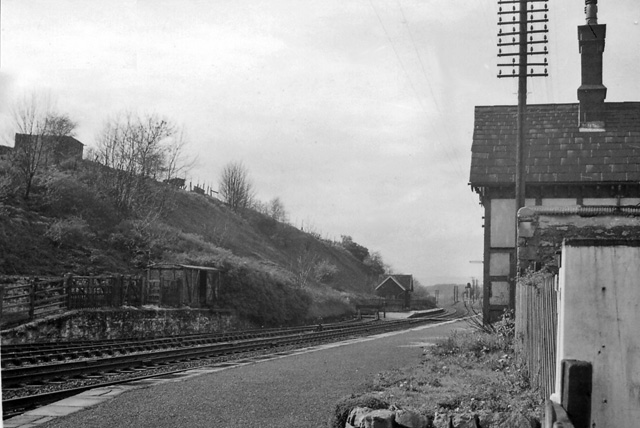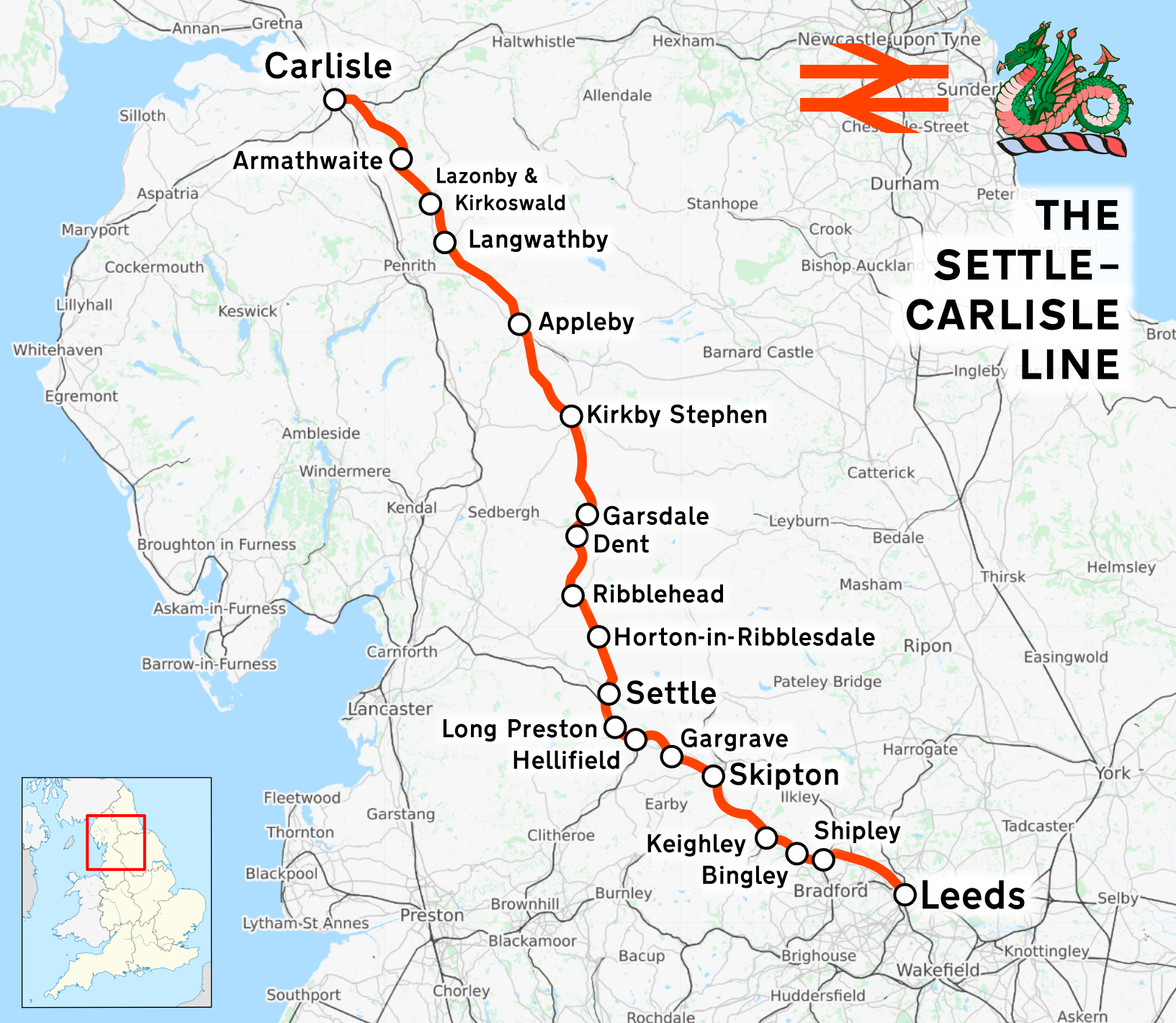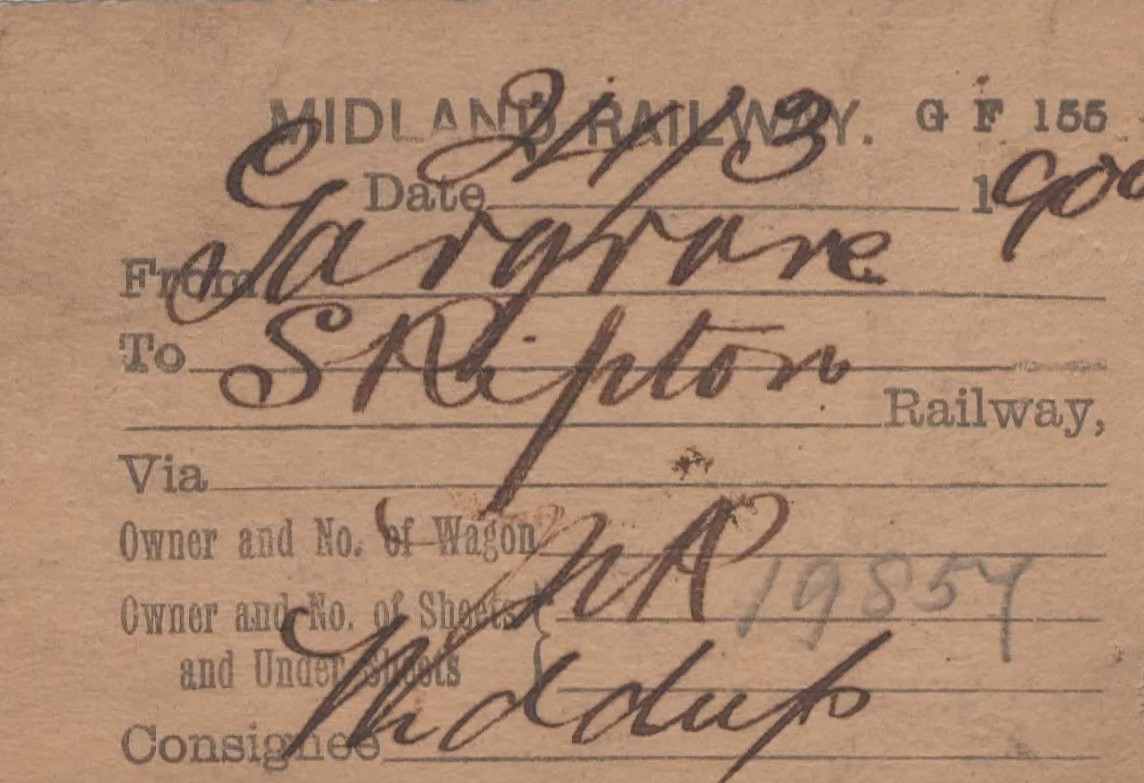|
Leeds–Morecambe Line
The Leeds–Morecambe line, also known as the Bentham line, is a railway line running between Leeds, Skipton, Lancaster and Morecambe in northern England. The service is operated by Northern. The route covered by the service was historically part of the Midland Railway. The line is electrified at 25 kV AC overhead between Leeds City and Skipton- this section is known as the Airedale line. The route Airedale line (Leeds–Skipton) The first section, between Leeds City and was opened by the Leeds and Bradford Railway on 1 July 1846, and extended to Skipton by the Leeds and Bradford Extension Railway. Skipton–Settle The line from here, known as the "Little" North Western Railway, opened as far as Clapham on 30 July 1849 and through to on 1 June 1850. Here were junctions for the following lines: * the Yorkshire Dales Railway, opened 30 July 1902, closed 22 September 1930, and which linked to the Skipton–Ilkley line * the continuation of Leeds and Bradford Extens ... [...More Info...] [...Related Items...] OR: [Wikipedia] [Google] [Baidu] |
West Yorkshire
West Yorkshire is a metropolitan and ceremonial county in the Yorkshire and Humber Region of England. It is an inland and upland county having eastward-draining valleys while taking in the moors of the Pennines. West Yorkshire came into existence as a metropolitan county in 1974 after the reorganisation of the Local Government Act 1972 which saw it formed from a large part of the West Riding of Yorkshire. The county had a recorded population of 2.3 million in the 2011 Census making it the fourth-largest by population in England. The largest towns are Huddersfield, Castleford, Batley, Bingley, Pontefract, Halifax, Brighouse, Keighley, Pudsey, Morley and Dewsbury. The three cities of West Yorkshire are Bradford, Leeds and Wakefield. West Yorkshire consists of five metropolitan boroughs (City of Bradford, Calderdale, Kirklees, City of Leeds and City of Wakefield); it is bordered by the counties of Derbyshire to the south, Greater Manchester to the south-west, Lancash ... [...More Info...] [...Related Items...] OR: [Wikipedia] [Google] [Baidu] |
"Little" North Western Railway
The North Western Railway (NWR) was an early British railway company in the north-west of England. It was commonly known as the "Little" North Western Railway, to distinguish it from the larger London and North Western Railway (LNWR). The NWR was first leased, and later taken over, by the Midland Railway (MR). The MR used part of the line for its London to Scotland Settle and Carlisle main line. The NWR main line, which ran from Skipton in the West Riding of Yorkshire to Morecambe on the Lancashire coast, gave the MR access to the west coast in an area dominated by the rival LNWR. Part of the line, between Lancaster and Morecambe, was used in the early twentieth century for pioneering overhead electrification. Two-thirds of the line, in North Yorkshire, is still in use today, mainly for local services. Of the dismantled Lancashire section, two-thirds has been reused as a combined cyclepath and footpath. Formation The North Western Railway was incorporated on 26 June 1846 to ... [...More Info...] [...Related Items...] OR: [Wikipedia] [Google] [Baidu] |
Ingleton, North Yorkshire
Ingleton is a village and civil parish in the Craven district of North Yorkshire, England. The village is from Kendal and from Lancaster on the western side of the Pennines. It is from Settle. The River Doe and the River Twiss meet to form the source of the River Greta, a tributary of the River Lune. The village is on the A65 road and at the head of the A687. The B6255 takes the south bank of the River Doe to Ribblehead and Hawes. All that remains of the railway in the village is the landmark Ingleton Viaduct.OS map 98, Wensleydale and Upper Wharfdale. Arthur Conan Doyle was a regular visitor to the area and was married locally, as his mother lived at Masongill from 1882 to 1917 (see notable people). It has been claimed that there is evidence that the inspiration for the name Sherlock Holmes came from here. Whernside, north-north-east of the village, one of the Yorkshire Three Peaks, is the highest point in the parish at . There are major quarries within the paris ... [...More Info...] [...Related Items...] OR: [Wikipedia] [Google] [Baidu] |
Clapham, North Yorkshire
Clapham is a village in the civil parish of Clapham cum Newby in the Craven district of North Yorkshire, England. It was previously in the West Riding of Yorkshire. It lies within the Yorkshire Dales National Park, north-west of Settle, and just off the A65 road. History The church of St James in Clapham was founded in Norman times, and originally dedicated to St Michael. It is mentioned in records dating back to 1160. The village and church were burned during a Scottish raid following the Battle of Bannockburn in the early 14th century. The church tower was probably erected following this incident, but the rest of the church dates from the 19th century. In the 14th century John de Clapham, who took his surname from the village, was a supporter of the Earl of Warwick and lived at Clapdale Castle. His descendants took part in the Wars of the Roses on the side of the House of Lancaster. Since the 18th century Clapham has been home to the Farrer family who established their ... [...More Info...] [...Related Items...] OR: [Wikipedia] [Google] [Baidu] |
Giggleswick
Giggleswick, a village and civil parish in the Craven district of North Yorkshire, England, lies on the B6480 road, less than north-west of the town of Settle and divided from it by the River Ribble. It is the site of Giggleswick School. The village belonged to the West Riding of Yorkshire until 1974. Etymology ''A Dictionary of British Place Names'' contains the entry: :Giggleswick N. Yorks. Ghigeleswic 1086 (DB). "Dwelling or (dairy) farm of a man called Gikel or Gichel". OE or ME pers. name (probably a short form of the biblical name Judichael) + wīc. Railway station The village is served by Giggleswick railway station, which provides services to Leeds and to Lancaster and Morecambe. There are five trains a day in each direction, operated by Northern. Close to the station and opposite the ''Craven Arms Hotel'' (formerly the ''Old Station Inn'') is the Plague Stone. This has a shallow trough, which in times of plague was filled with vinegar to sterilize the coins ... [...More Info...] [...Related Items...] OR: [Wikipedia] [Google] [Baidu] |
Settle–Carlisle Line
The Settle–Carlisle line (also known as the ''Settle and Carlisle'' (S&C)) is a main railway line in northern England. The route, which crosses the remote, scenic regions of the Yorkshire Dales and the North Pennines, runs between Settle Junction, on the Leeds–Morecambe line, and , near the English-Scottish borders. The historic line was constructed in the 1870s and has several notable tunnels and viaducts such as the imposing Ribblehead. The line is managed by Network Rail. All passenger services are operated by Northern apart from temporary diverted services (due to closures of the West Coast Main Line) and are part of the National Rail network. Stations serve towns such as Settle in North Yorkshire, Appleby-in-Westmorland in Cumbria and small rural communities along its route. In the 1980s, British Rail planned to close the Settle–Carlisle line. This prompted a campaign to save the line by rail groups, enthusiasts, local authorities and residents along the route. ... [...More Info...] [...Related Items...] OR: [Wikipedia] [Google] [Baidu] |
Hellifield Engine Shed
Hellifield Engine Shed was a railway locomotive depot adjacent to railway station in North Yorkshire, England. The depot opened in 1880 and was closed in 1963. Its main function was to house engines for use on the Settle-Carlisle line. Hellifield was coded as 30A, 20G, 23B, and 24H and was a sub-shed of first Skipton depot, and latterly under Accrington depot. History Hellifield was opened as depot in 1880 and its purpose was the supply of engines for the four lines radiating from Hellifield, though its most important duty was to provide relief and pilot engines for trains running to Carlisle. This was deemed necessary because of the 1-in-100 climb up to Ais Gill. The railway climbs continually from Hellifield to Ais Gill, a section known as the ''Long Drag'', where it attains a height of . The sheds were furnished with a turntable, made by Cowans & Sheldon at a cost of £325, though it was not ready for when the station and shed opened. This resulted in some locomotives ... [...More Info...] [...Related Items...] OR: [Wikipedia] [Google] [Baidu] |
Malham
Malham is a village and civil parish in the Craven district of North Yorkshire, England. Before 20th century boundary changes, the village was part of the Settle Rural District, in the historic West Riding of Yorkshire. In the ''Domesday Book'', the name is given as Malgun, meaning "settlement by the gravelly places". In 2001 the parish had a population of approximately 150. Malham parish increased in size geographically (to include Malham Moor) and so at the 2011 Census had a population of 238. Malham lies at the upper end of the valley of the River Aire, known above Airton as Malhamdale, in the Yorkshire Dales. The surrounding countryside is well known for its limestone pavements and other examples of limestone scenery. Tourist attractions include Malham Tarn, Malham Cove, Gordale Scar, Janet's Foss and the Dry Valley. In the 1950s the village gave its name to a Ham class minesweeper, HMS Malham. Governance Malham has a joint parish council, Kirkby Malhamdale Parish Counci ... [...More Info...] [...Related Items...] OR: [Wikipedia] [Google] [Baidu] |
Bell Busk Railway Station
Bell Busk railway station served the hamlet of Bell Busk in North Yorkshire, England. It was located on the Leeds to Morecambe Line between and Hellifield, north of . History It was opened by the "Little" North Western Railway in July 1849 as one of the intermediate stations on their line between and Ingleton, which subsequently became part of a through route between West Yorkshire and the Lancashire seaside town of Morecambe (and ultimately part of the Midland Railway main line from London to Scotland). The main buildings were located on the southbound side, whilst the two offset platforms were initially linked by a foot crossing. This however was subsequently replaced by a footbridge, possibly as the result of a fatal accident on the crossing in 1880 that resulted in the deaths of two elderly travellers. Although situated some way from the nearest large communities, it was the most convenient station for the village of Malham and the surrounding countryside - a popular ... [...More Info...] [...Related Items...] OR: [Wikipedia] [Google] [Baidu] |
Gargrave Railway Station
Gargrave is a railway station on the Bentham Line, which runs between and via . The station, situated north-west of Leeds, serves the village of Gargrave in North Yorkshire. It is owned by Network Rail and managed by Northern Trains. History The station was opened on 30 July 1849 by the "Little" North Western Railway, later taken over by the Midland Railway. The original stone shelters survive on each platform, but the main wooden station building is now in private use. Stationmasters *Peter William ca. 1851 *W. Renshaw until 1861 (afterwards station master at Berkley Road) *John Bell 1861 - ca. 1866 *W. Lewin (formerly station master at Oxenhope) *Thomas Stone ca. 1871 - 1893 *David Bennett Smith 1893 - 1901 (afterwards station master at Manningham) *James Staff 1901 - 1920 (formerly station master at Oxenhope) Facilities It is unstaffed and until 2019 had no ticket machine (so travellers had to buy tickets in advance or on the train). A new ticket machine has now b ... [...More Info...] [...Related Items...] OR: [Wikipedia] [Google] [Baidu] |
Lancashire And Yorkshire Railway
The Lancashire and Yorkshire Railway (L&YR) was a major British railway company before the 1923 Grouping. It was incorporated in 1847 from an amalgamation of several existing railways. It was the third-largest railway system based in northern England (after the Midland and North Eastern Railways). The intensity of its service was reflected in the 1,650 locomotives it owned – it was by far the most densely-trafficked system in the British Isles with more locomotives per mile than any other company – and that one third of its 738 signal boxes controlled junctions averaging one every . No two adjacent stations were more than apart and its 1,904 passenger services occupied 57 pages in '' Bradshaw'', a number exceeded only by the Great Western Railway, the London and North Western Railway, and the Midland Railway. It was the first mainline railway to introduce electrification of some of its lines, and it also ran steamboat services across the Irish Sea an ... [...More Info...] [...Related Items...] OR: [Wikipedia] [Google] [Baidu] |







